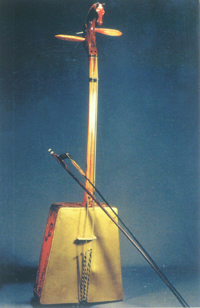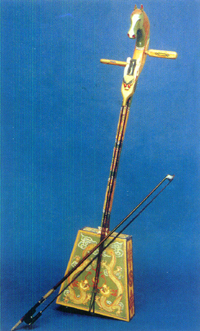The top of the neck of the
horse-headed stringed instrument is carved in the shape of a horse's head, hence
the name, and it is the representative instrument of the horse-riding Mongolian
people. The sound box is trapezoid in shape, and decorated with ethnic motifs.
The instrument has two strings with a four-octave range, and it is played with a
horsetail-hair bow on the outside of the strings. Double tones can be played on
it.
Its hazy tone color is suitable for
expressing soft and mellow moods. Its haunting melodies can often be heard on
the vast Mongolian grasslands; whether in solo performance or accompanying
folksongs, its quavering notes, using the third or fourth octave, sound like the
human voice.
Besides its unique enchantment,
the Horse-Headed Qin also has its interesting legend of origin: long ago,
there lived a robust young man in the Mongolian grassland. This young man was a
good folk singer and as long as he sang, one of his white horses would cry with
the melody of its master. They two thus became good friends, and in a horse
race, this white horse helped the young man win the first prize. The landlord,
however, also wanted to have this magical horse, and he finally succeeded in
holding the horse as his own by force. The white horse missed his former master
so much that one day it escaped from the cruel landlord. Although it got the
deadly shot from the landlord, the horse insisted on running and fell to the
feet of the young man. In memory of this white horse, the young man made one
musical instrument with the remains of the horse: its head bone as the sound box
and the tail as the outside bow, and decorated it with carving a horse head.
This is the first Horse-Headed Qin.


